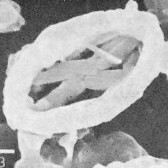Davidhakania imbriei
Set number: 1881
-
1
-
2
-
3
-
4
-
5
-
6
-
7
-
8
-
9
-
10
-
11
-
12
-
13
-
14
-
15
-
16
-
17
-
18
-
19
-
20
-
21
-
22
-
23
-
24
-
25
-
26
-
27
-
28
-
29
-
30
-
31
-
32
10µm
In the mobile mount
Set number: 1879
-
1
-
2
-
3
-
4
-
5
-
6
-
7
-
8
-
9
-
10
-
11
-
12
10µm
Neochiastozygus imbriei Haq & Lohman, 1976
This species of Davidhakania is characterised by an asymmetrical diagonal cross, with its acute angle aligned along the long axis of the discolith. The longer arm is inclined less than 20° (often less than 10°) counterclockwise relative to the long axis of the discolith on the distal side. Its optical properties are consistent with those of the genus Davidhakania. This species exhibits extinction lines with a typical extinction angle of approximately 74° on the distal side and displays length-fast (-) elongation.
Davidhakania imbriei differs from Davidhakania eosaepes in the alignment of the longer arm of the crossbar. In Davidhakania imbriei, the longer arm is inclined less than 20° counterclockwise relative to the long axis of the discolith on the distal side, whereas in Davidhakania eosaepes, it is inclined more than 20°.
Davidhakania eosaepes is further distinguished by its asymmetrical crossbar, whereas Davidhakania saepes and Davidhakania partingtonii possess symmetrical crossbars.
Haq, B. U. & Lohmann, G. P. 1976. Early Cenozoic calcareous nannoplankton biogeography of the Atlantic Ocean. Marine Micropaleontology. 1: 119-194.
Varol, O. 2025a. A practical guide to optical studies of calcareous nannofossils. Grzybowski Foundation Special Publication. 29: 1-222
